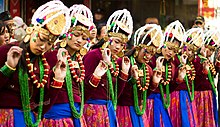
Back Таму Byelorussian গুরুং জনজাতি Bengali/Bangla Gurung German Γκουρούνγκ (λαός) Greek Gurungoj Esperanto Gurungs French Gurung Italian グルン Japanese გურუნგები Georgian Гурунг Kazakh
 Gurung Ghatu Dance in Tamu losar festival | |
| Total population | |
|---|---|
| c. 795,290[citation needed] | |
| Regions with significant populations | |
| Manang, Lamjung, Mustang, Gorkha, Kaski, Tanahun, Syangja and Dolpa | |
| 543,790 (2021)[1] | |
| 139,000 (above)[2] | |
| 28,700[citation needed] | |
| 16,800[citation needed] | |
| 15,200[citation needed] | |
| 12,800[citation needed] | |
| 11,300[citation needed] | |
| 9,600 | |
| 7,500[citation needed] | |
| 4,500[citation needed] | |
| 3,300[citation needed] | |
| 2,800[citation needed] | |
| Languages | |
| Nepali (Lingua Franca), Gurung (Tamu kyi, Manangi, Mustangi, Loki), Seke | |
| Religion | |
| Buddhism (62.7), Bon (2.32%), Christianity (2.12%) Hinduism (32.86%) [3] | |
| Related ethnic groups | |
| Tibetan, Qiang, Tamang, Magar, Thakali, Sherpa | |
| Gurung people | |||||
|---|---|---|---|---|---|
| Tibetan name | |||||
| Tibetan | ཏམུ | ||||
| |||||
Gurung (exonym; Nepali: गुरुङ) or Tamu (endonym; Gurung: ཏམུ) are an ethnic group living in the hills and mountains of Gandaki Province of Nepal.[4] Gurung people predominantly live around the Annapurna region in Manang, Mustang, Dolpo, Kaski, Lamjung, Gorkha, Parbat,Tanahun and Syangja districts of Nepal.
They are also scattered across India in Sikkim, Assam, Delhi, West Bengal (Darjeeling area) and other regions with a predominant Nepali diaspora population.[5] They speak the Sino-Tibetan Gurung language and most of them practice the Bon religion alongside Tibetan Buddhism and Hinduism. Gurung has a Sino-Tibetan dialect cluster that is a part of the Tamangic family. The people who speak them are ethnically Tamang, but their languages are too poorly known to be sure. Genetically, Tamang was classified by Shafer as belonging to Gurung Branch of the Bodish Section of the Bodic Division of Tibeto-Burman (1955). Gurungs are highly influenced by Magar civilisation of Nepal specifically cultural dances and dresses. The Bakhu is the cultural dress for Gurungs.
The origin of the Gurung people can be traced back to Qiang people located in Qinghai, China. As a result of foreign and Korean Christian missionary activities, some Gurung people have also converted to Christianity.[6]
- ^ National Statistics Office (2021). National Population and Housing Census 2021, Caste/Ethnicity Report. Government of Nepal (Report).
- ^ "Rai-Peoplegrouporg".
- ^ Central Bureau of Statistics (2014). Population monograph of Nepal (PDF) (Report). Vol. II page 56. Government of Nepal.
- ^ Ragsdale, T.A. (1990). "Gurungs, Goorkhalis, Gurkhas: speculations on a Nepalese ethno-history" (PDF). Contributions to Nepalese Studies. 17 (1): 1–24.
- ^ Central Bureau of Statistics (2012). National Population and Housing Census 2011 (PDF). Kathmandu: Government of Nepal
- ^ Central Bureau of Statistics (2014). Population monograph of Nepal (PDF) (Report). Vol. II. Government of Nepal.
© MMXXIII Rich X Search. We shall prevail. All rights reserved. Rich X Search